Menus
- Travelers with character
- Discovery
- In the saddle
- In the city
- Motorway and expressways
- Departmental
- Part-cycle
- Braking
- Comfort / Duo
- Consumption
- Conclusion
- BMW R1200RS
- Kawasaki Z1000SX
- BMW R1200RS
- Kawasaki Z1000SX
Travelers with character
Traveling on a motorcycle does not rhyme exclusively with large GTs, efficient but cumbersome, or maxi-Trails, useful but too distinctive. The alternative is called sport-GT. These mixed machines are often based on a sports roadster base, greatly improved in long distance attributes.. This segment seems to be experiencing a resurgence in popularity. Merit goes, since 2010, to the Kawasaki Z1000SX which represents 25% of sales in this market…. Facing her, Honda aligns its VFR 800 and VFR 1200. If the first remains a safe bet but of average displacement, the second has not known, far from it, the success of its sister. Because on this ground of compromise, the alchemy must be subtle. It is to a specialist of the genre that we owe a new challenger: BMW and its new R1200RS. The German manufacturer thus reaffirms its long-standing experience, once symbolized by the R1100RS and R1100S. We will therefore oppose the last Bavarian steed to the champion of Akashi the time of an escapade, necessarily dynamic..

Discovery
Newcomer, the Munichoise has no shortage of arguments to seduce, starting with its resolutely sporty style. Borrowed from the reference of the circuits, the S1000RR, the front face of course retains an asymmetry studied at the level of the lights, but the machine is dressed in elegance. Fairly wide, the sides are fitted, laterally, with additional deflectors. They are added, in the lower part, to architectural scoops, double multilayer elements, deflecting air flows. Above, a screen adjustable over 40 mm via two positions (or 4 with tools), complete the faired assembly.
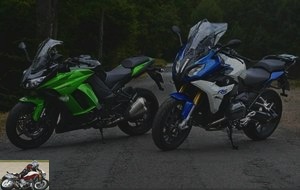
On the Japanese side, we are also inspired by a sports icon, the Ninja ZX10R, again primed for more road use. However, the Kawasaki more noticeably retains a racing aesthetic. Tapered, the optics stretch over a flattened fairing head, embellished with a narrow curved bubble and adjustable on three levels. On either side, the scoops widen out into wide sides, then plunging down to the bottom of the machine in a narrow shoe. Sport is not far away.
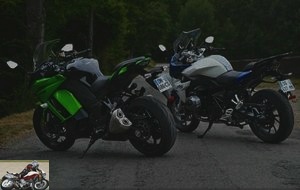
The rear of the machines takes up this already perceptible difference between the two travelers. Rather horizontal, the rear steel tube loop of RS is minimalist but supports wide seats. More sheathed, but also more raised, the aluminum stern of the SX offers a neat finish. And above all, she iintegrates suitcase racks. A pioneer in this field on these R1200RT and R1200GS, BMW ignores such a system here. A simple and unsightly supernumerary tube is bolted to the frame…. As on the first generation of its competitor. Strange choice.
Not available for the test, remember that the luggage of both are particularly qualitative and their use intuitive. Each accommodates an integral but those of the German are larger (31 and 32 liters against two times 28).
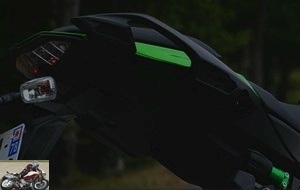
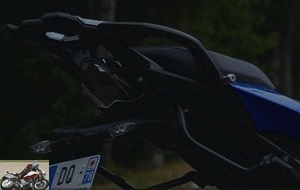
Engine side, it is the total opposition. BMW is taking back its 1,170 cm3 twin, integrated as a load-bearing element within the new aluminum double beam frame. The first develops 125 hp at 7,750 rpm and reaches its maximum torque of 12.5 da.Nm at 6500 revolutions / min, with 10 da.Nm available at minimum. The second is strong 138 hp at 9,600 rpm and 11 da.Nm at 7,800 rpm. German mechanics are, of course, under electronic control with, as standard, two engine maps (Road and Rain, smoothing the block’s response), ABS and ASC (anti-skating). And of course, the final transmission is done by shaft and universal joint, via the single-sided swingarm. A real plus in the long run. Our machine is equipped with optional ESA suspensions but receives, by default, a 45 mm inverted fork not adjustable. The rear shock absorber is then adjustable in preload via a dial on the right side and associated compression-relaxation by a practical command at its base. We appreciate the arrangement of the air pressure valves on a rim branch. However, some connectors could be better integrated. You will find all the technical details in testing the R1200RS.
On the Japanese, ABS is now standard and the KTRC traction control has three levels of adjustment. Two engine maps are also available, Full and Low, then limiting the power to 80% of the maximum and modulating the throttle response. The chain transmission benefits from an aesthetic and practical tension by eccentric, on an equally remarkable double oscillating arm. Kawasaki equips its mount with a 41 mm reverse steering gear associated with a rear handset, all two fully adjustable. The anodized finish of the controls and caps is particularly rewarding. You will find all the technical details in testing the Z1000SX.
We will also note a better integration of the components on the Japanese. Footrest plates, accompanying handles, satin exhaust mufflers, etc.). As an option, the German receives a central stand, an element impossible to attach to the Kawasaki because of the catalyst placed under the machine.
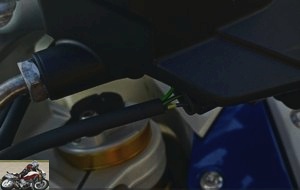
In the saddle
The specificities of each machine are accentuated as soon as you get in the saddle. On the BMW, the seats are particularly comfortable for the crew. That of the pilot, wide and long, culminates at 820 mm and its narrowness at the level of the tank optimizes accessibility. reasonably bent, the legs benefit from an important place. The passenger also finds a comfortable position and effective support. Its rival offers a reception at the same height but more sporty and gives the impression of being placed on the machine, while one is "in" the German. Higher, the footrests induce a slightly greater flexion. The accompanying person has ergonomic handles but placed too far forward, hampering his ease. Likewise, the pressure on the half-handlebars of the SX is sensitive, while the RS leaves a more natural position.
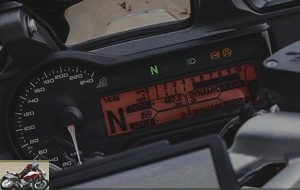
More recent, the Bavarian has a complete instrument unit, combining analog tachometer and large digital screen, whose display ergonomics are even variable. However, it is difficult to intuitively read the speed on the left dial. The LCD window is much more compact on the Kawasaki, but is more fortunately associated with a needle tachometer. In use, this is more efficient in dynamic piloting. The main forgetting is that of the gear indicator engaged…. Finally, the ergonomics of the controls are correct on both models, but Akashi’s machine benefits from pushers that are easier to use. All electronic functions are available in the tests R1200RS and Z1000SX.
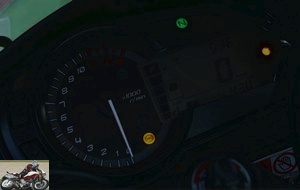
In the city
Two chants mingle. The rumbling one of the BMW responds to the hoarse growl of the Kawa. Straight away, the selection of the latter is more pleasant. The box slams less and locks naturally, especially on the first three reports. Moreover, the four-cylinder is well available and flexible, capable of picking up at 30 km / h in the last gear. The twin, in its liquid version, has lost its roundness at low revs. Second of rigor, which makes the evolutions less smooth. Because the higher speed makes the flat hiccup below 2000 rpm.

The German makes up for it in comfort, its ergonomics being more conducive to urban developments. Thus, the wrists suffer little from recurrent braking. There is also a better retrovision. In traffic, the two machines show comparable agility. Their similar weight (236 kg for the RS and 231 kg for the SX ABS) does not hamper their ease in maneuvering. Engine off, the Kawa is however easier to handle. On a daily basis, both will easily satisfy city use, while waiting for the Sunday outing, or even more..

Motorway and expressways
Sharpened, the flat twin now has an assertive sporty character, that the great outdoors allow to appreciate. Chomping at the bit on the legal motorway, 4,300 rpm, it resumes vigorously in all gears, rising without hesitation towards its red zone. Screen in high position, the protection is effective up to more than 170 km / h and the perfect course hold. Only the arms take more air. The SX doesn’t give that much. More aerodynamic, its CX allows more flow to pass over the upper body and its bubble logically deflects the wind pressure less. The greatest will then rail against a saddle that is too short, limiting recoil. However, the whole remains effective in cutting down the kilometers, the support generated reducing that of the body on the front. On board, vibrations remain contained and the multi-cylinder block is quick to react to acceleration. However, at 5,000 revolutions-minutes for 130 km / h, it is necessary to fall into 5th gear to spring towards the horizon with more force..
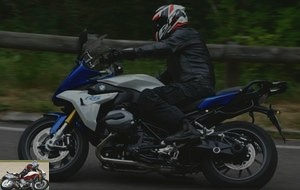
But when it comes to covers, the Z1000SX does better than its sidekick, whatever the starting speed. 90, 110, 130…. the Kawa escapes. Little, certainly, but inevitably. Likewise on a standing start, the Japanese always nibbles a length. Not enough to take offense at the handlebars of the R1200RS, which is biding its time on the secondary network.
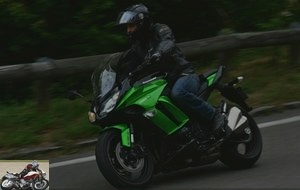
Departmental
The brand’s flat twin models with the propeller have a particular balance, an unusual ease on roads. On the strength of this genetics, novelty drives home the point, delivering a agility and exciting evidence. We take the frame effortlessly, looking at it, passing from one curve to another as if remotely controlled by the very high manufacturer. The tight ferrule further highlights this rigid chassis, guided by a slightly light front axle. Devoid of Telever, it loses in neutrality but gains in ease, under the supervision of a steering damper.
Riding the SX, it’s always more sport, the Kawa requiring more engagement in the sequences. Dynamic, however, its chassis reacts effectively to impulses handlebar / footrest, turning a block. Without reproach in large curves, the faster changes of angles require, comparatively, a little more application to pass from one edge to the other. Corn its front axle provides a better reading of the bitumen. Particularly well suspended on its non-piloted equipment, the Japanese allows fine adjustment, but manual, of its suspensions. These work efficiently, absorbing small and medium defects in the bitumen. On larger compressions, the shock is a little drier, as is the fork, which, by default, plunges noticeably.
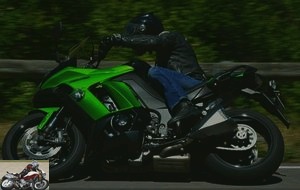
Same observation on the Bavarian and its electronic damping, favoring a certain comfort, even in Dynamic mode. Particularly effective for clearing irregularities in the road, the optional ESA brings a real plus in case of recurring duo or use of suitcases. However, the setting is still an average rating. Some people would probably prefer more firmness or, on the contrary, more comfort at extreme values..
Mechanical side, the important torque of the BMW works wonders, energizing curve exits. And, now having a powerful extension in high revs, the R1200RS remains a very first class weapon in the segment. Vibrant, the soundtrack is enriched with backfires on downshifting. On board, we drive on the "fat" of the twin, catapulted with each go-around from mid-revs. A pleasure that the followers of the high revolutions specific to four cylinders taste less. The Z1000SX works happily from 5,000 rpm but gets really annoyed beyond 7,500 rpm. Its rumble turns into a turbine and the block then seeks to orbit you, as it approaches the red zone. Powerful and long, its breath works wonders on slender lines, borrowed at brisk pace.
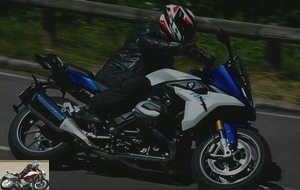
On the angle, the Kawasaki tends to straighten up when the brakes are applied. Her Bavarian rival is less sensitive on this point, but without Telever, she now freezes more on her fork. Good braking machines, the two machines offer a different feeling. Biting as soon as you take the lever, the calipers of the SX deliver powerful decelerations but less progressive than those of its opponent. On the latter, the dead travel of the lever seems very long, but the system is efficient, allowing more control. Finally, each of the GT-sports admits a little timid rear clamps.
Part-cycle
Lively and rigid, today’s competitors offer a different philosophy. However, their effectiveness remains close. The BMW undoubtedly provides greater ease to the handlebars but its front end remains stingy in feedback. More precise, under the constraint, that of the Kawasaki appreciates the piloting with the scalpel.
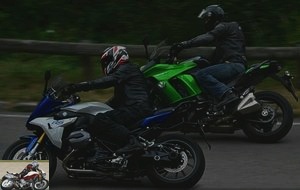
Braking
One-piece radial brembo for Akashi’s maid. These front calipers are perfectly sized for sports trips in duo. However, their implementation requires a little gentleness. The Munich beauty displays clamps from the same supplier, not monobloc, providing more progressiveness. On the attack, the BMW seems easier to master on this point.
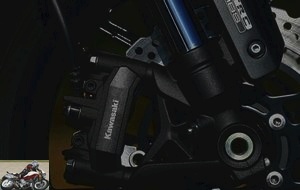
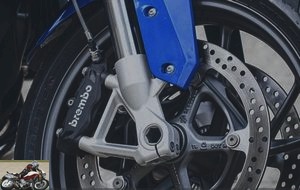
Comfort / Duo
Without hesitation, the R1200RS does wonders on this subject. Geometry and saddles are tailored for long trips. Likewise, the protection on board is more important than that of its rival. However, the latter delivers correct services, in line with its more sporty positioning..
Consumption
The flat is less greedy, with an average of 6 L / 100 km, or nearly a unit less than that of the four-cylinder. At the same capacity, 18 liters, the maximum autonomy varies between 300 and 250 km respectively..
Conclusion
It is not so easy to decide between our two machines. Their geometry and mechanics clearly oppose them. Flat twin, German steel tubular frame, universal joint, column angle (27.7 °) and superior length of the BMW (10 cm) face four Japanese cylinders, aluminum double beam chassis, chain distribution and a much more closed steering ( 24.4 °). Efficiency is at the rendezvous but gives each a very different grip.

Their price could make the difference. Available as standard against 14,105 €, the German is more expensive than the 13,399 € of the Japanese ABS. And, at this price, the BMW presents a qualitative non-piloted fork but devoid of adjustments…. To get the RS from our test, we will still have to pay € 1,445 for the Touring Pack (including ESA, regulator, center stand, luggage rack, case supports….) And 595 more for the Dynamic Pack (including DTC, piloting mode….) Or around € 2,000 more, for a total of € 16,145. What to afford suitcases, heated grips, comfort saddle and gear indicator engaged (€ 1,356 in total) to equip the SX.
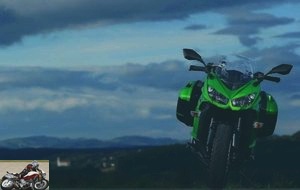
Both compete for points, both in terms of finish and pleasure and style of driving or use. Certainly the proof of excellent performance for each, in a segment where the BMW has yet to prove its commercial success. The R1200RS is a GT-sport, the Z1000SX a sport-GT…. important nuance when choosing. Everyone’s expectations and type of management will condition the decision. Thus, lovers of long, dynamic trips and the latest optional technological refinements will prefer the comfort of the German, especially in duo. Finally, the unwavering breakers of terminals on the lookout for an arsouille, will choose the homogeneous and proven efficiency of the Kawasaki..
Strong points
BMW R1200RS
- Engine character and availability
- Agility of the chassis
- Gimbal
- Comfort
Kawasaki Z1000SX
- Engine character and availability
- Sportiness of the chassis
- Finishes
Weak points
BMW R1200RS
- Screen perfectible in mechanism
- Finishing details
Kawasaki Z1000SX
- Perfectible protection
- Comfort
- The technical sheet of the BMW R1200RS
- Kawasaki Z1000SX technical sheet
Related articles
-
Comparison test Triumph Tiger 900 GT Pro and Rally Pro
Annexation of new territories 3 cylinders in line, 888 cm3, 95.2 hp, 87 Nm, 198 kg and 201 kg, euros Although the creative nation of rugby, the English…
-
BMW F 900 R and F 900 XR comparison test
The evolutions of the 850 with the look of the 1000XR sport trail and the R1250R roadster Inline twin, 895 cm3, 105 hp, 92 Nm, Euro5, 211 and 219 kg BMW…
-
Kawasaki Ninja 125 and Z125 comparison test
Dreams of big children 4-stroke single cylinder, 125 cm3, 15 hp and 11.7 Nm, 146 kg full made, from 4,599 euros The 125 cm3 motorcycle segment is an…
-
Honda CB500F, CB500X and CBR500R comparison test
Three-variable equation, proof by X A roadster, a sports car and a trail, 3 possibilities 500 Two boys, a girl … a roadster, a sportswoman, a trail,…
-
KTM 790 Adventure and Adventure R motorcycle comparison test
New icon, Easy Adventure 95 hp at 8,000 rpm and 89 Nm at 6,600 rpm KTM, it was the master of the single cylinder, then of the maxi trail but was absent…
-
TGV first class Five years ago, Kawasaki presented its first Z1000SX, a road version of its Z 1000 reference roadster. A versatile machine, which has…
-
Ducati Hypermotard 950 and SP motorcycle comparison test
The art of irreverence L-Twin of 937 cm3, 114 hp and 9.8 mkg, 200 kg full made, from 12,690 euros What is a Hypermot ‘? If we say it’s a mix of supermot…
-
Harley-Davidson Breakout FXSB Test
Escape on the run Building on the success of its ultra high-end CVO Breakout, produced in a limited series of 500 copies, the Milwaukee firm is now…
-
Character legend Completely redesigned but faithful to its legend and its aesthetic codes, the Bonneville reinvents itself with talent and efficiency in…
-
Comparison test for KTM 690 SMC-R and Enduro R motorcycles
Mono multi-pleasures Single cylinder LC4, 690 cm, 74 hp and 73.5 Nm, WP suspensions, Brembo brakes, 10,799 euros The very DNA of the brand, the…
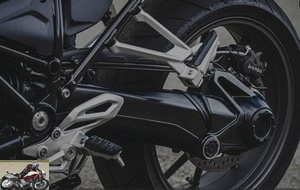
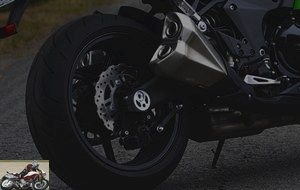
Thanks, great try. I looked on the net and did not find any aftermarket suspensions. Do people have any info on this, because I’m not a fan of the stock shocks either??
PS: agree with the "do we need more". I sold my Caponord 1200 for the Xmax … Great bike, but here it is.
Thanks, great try. I looked on the net and did not find any aftermarket suspensions. Do people have any info on this, because I’m not a fan of the stock shocks either??
PS: agree with the "do we need more". I sold my Caponord 1200 for the Xmax … Great bike, but here it is.
hello, yamaha 300 is too shit, too much oar 125 km / h pffff too expensive, too bad, I drove honda forza 300 ABS full, very good and very powerful more 155 km / h woohoo, big thank you mister your con yamaha c lightning shit, too expensive from 5700 euros lollll
finally back from vacation I just caught up with all the videos that I hadn’t been able to see, I missed you, little friction at the end, it will become a new criterion of choice whether it rubs or not .. \
Bluestacks TextNow VPN
continuation of my column, with almost 42000km on the clock now: rear tire changed at 25000km for a City grip which holds the road better and over time, front tire changed at 34000km for a city grip winter (same comment), the brake pads before 41000km. everything is still going well except a little monitoring on the right fork spinnaker, because there are traces of greasy dust which appear at times. for the moment I do not envisage heavy intervention because the seal is not wet and on the xmax 250 it had held 50,000km in this state. it looks a bit filthy, that’s all.
the fuel consumption is now stabilized between 2.4 and 2.9l / 100km depending on driving (overall quiet), and I change the transmission belt every 30,000km instead of the 20,000km recommended.